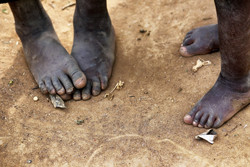Treatment for Buruli ulcer disease
BUD is a rare, poverty-related infection caused by Mycobacterium ulcerans that predominantly affects African children. Patients present with a progressive necrosis of skin, subcutaneous tissue and bone, but the transmission mode of BUD remains elusive. Scientists on the EU-funded 'Identification and development of vaccine candidates for Buruli Ulcer Disease' BURULIVAC project wished to investigate BUD pathogenesis and immunity mechanisms as well as develop novel therapeutic tools. Central to the project work was the capacity development of partner African institutions with respect to immunological analyses, treatment and disease management. Among the key findings of the project were the pathophysiological impact of the bacterial mycolactone toxin and the identification of its molecular targets. Using a combination of biochemical assays, cellular imaging and animal models, researchers found that mycolactone interferes with the cell structure by altering its cytoskeleton. Upon infection, this damages the integrity of the epidermis and is responsible for BUD pathogenesis. Characterisation of patient immune responses indicated that infected individuals have an overall suppressed immune system with reduced levels of multiple chemokines, cytokines and immunoglobulins. This profile was associated with an infection-associated drop of glycolytic and oxidative metabolism. With respect to therapy, BURULIVAC performed extensive work towards the development of prophylactic vaccines. Live bacteria lacking the mycolactone toxin proved very effective at generating protective immunity against virulent strains of M.ulcerans. Partners also generated monoclonal antibodies against mycolactone, following a careful screening and pre-selection process of candidates for their protective capacity in a mouse model. Overall, the BURULIVAC study has increased awareness about BUD and raised the infrastructure and technological capacity in affected countries. The commercial development of a lead vaccine against BUD will no doubt provide novel prevention and therapeutic options against this debilitating disease.







